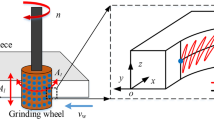Abstract
A force model of machining TC4 titanium alloy thin-walled part is developed based on the actual geometry and abrasive characteristics of CBN grinding head in this paper. Then, the single factor experiment illustrates that the grinding force increases with the increase of the grinding depth and feed rate, while it decreases with the increase of the spindle speed. And the contrast experiment results show that new improved grinding head is beneficial for reducing the force compared with common grinding head. On the basis of the mechanics analysis, the chatter stability of grinding thin-walled parts is studied based on the modal tests of titanium alloy thin-walled parts and grinding head, and the stability lobe diagrams are finally drawn as well by considering the radial grinding depth. In addition, further research indicates that the surface roughness of vertical side wall surface and surface micro-hardness is determined by several key parameters including spindle speed, feed rate, and cutting depth in grinding process based on analysis of experiments. An optimal combination of these parameters is of great benefit to achieving better surface of the parts.
Similar content being viewed by others
References
Masoudi S, Amini S, Saeidi E, Eslami-Chalander H (2015) Effect of machining-induced residual stress on the distortion of thin-walled parts. Int J Adv Manuf Technol 76(1–4):597–608
Heisel U, Kang C (2011) Model-based form error compensation in the turning of thin-walled cylindrical parts. Prod Eng 5(2):151–158
Habrat WF (2016) Effect of bond type and process parameters on grinding force components in grinding of cemented carbide. Procedia Eng 149:122–129
Walter C, Komischke T, Kuster F, Wegener K (2014) Laser-structured grinding tools - generation of prototype patterns and performance evaluation. J Mater Process Technol 214(4):951–961
Hecker RL, Liang SY, Wu XJ, Xia P, Jin DGW (2007) Grinding force and power modeling based on chip thickness analysis. Int J Adv Manuf Technol 33(5–6):449–459
Durgumahanti USP, Singh V, Rao PV (2010) A new model for grinding force prediction and analysis. Int J Mach Tool Manu 50(3):231–240
Yamaguchi H, Srivastava AK (2012) Magnetic abrasive finishing of cutting tools for machining of titanium alloys. CIRP Ann Manuf Technol 61(1):311–314
Badger JA, Torrance AA (2000) Comparison of two models to predict grinding forces from wheel surface topography. Int J Mach Tool Manu 40(8):1099–1120
Torrance AA, Badger JA (2000) The relation between the traverse dressing of vitrified grinding wheels and their performance. Int J Mach Tool Manu 40(12):1787–1811
Campa FJ, Norberto LDLL, Urbicain G, Lamikiz A, Seguy S, Arnaud L (2011) Critical thickness and dynamic stiffness for chatter avoidance in thin floors milling. Adv Mater Res 188:116–121
Mahaddalkar PM, Miller MH (2014) Force and thermal effects in vibration-assisted grinding. Int J Adv Manuf Technol 71(5–8):1117–1122
Karpuschewski B, Goldau H, Stolze R (2014) Process force and technology model for designing and controlling finishing operations with rotating grinding tools. CIRP Ann Manuf Technol 63(1):337–340
Gourc E, Seguy S, Michon G, Berlioz A (2013) Chatter control in turning process with a nonlinear energy sink. Adv Mater Res 698:89–98
Wang S, Li CH, Zhang DK, Jia DZ, Zhang YB (2014) Modeling the operation of a common grinding wheel with nanoparticle jet flow minimal quantity lubrication. Int J Adv Manuf Technol 74(5–8):835–850
Wang YG, Li CH, Zhang YB, Yang M, Li BK, Jia DZ, Hou YL, Mao C (2016) Experimental evaluation of the lubrication properties of the wheel/workpiece interface in minimum quantity lubrication (MQL) grinding using different types of vegetable oils. J Clean Prod 127:487–499
Ding Y, Zhu LD (2018) Investigation on chatter stability of thin-walled parts considering its flexibility based on finite element analysis. Int J Adv Manuf Technol 94:3173–3187. https://doi.org/10.1007/s00170-016-9471-x
Setti D, Sinha MK, Ghosh S, Rao PV (2015) Performance evaluation of Ti–6Al–4V grinding using chip formation and coefficient of friction under the influence of nanofluids. Int J Mach Tool Manu 88(88):237–248
Sikder S, Kishawy HA (2012) Analytical model for force prediction when machining metal matrix composite. Int J Mech Sci 59(1):95–103
Azizi A, Mohamadyari M (2015) Modeling and analysis of grinding forces based on the single grit scratch. Int J Adv Manuf Technol 78(5–8):1223–1231
Murtagian GR, Hecker RL, Liang SY, Danyluk S (2010) Plastic deformation depth modeling on grinding of gamma titanium aluminides. Int J Adv Manuf Technol 49(1–4):89–95
Zhang YB, Li CH, Ji HJ, Yang XH, Yang M, Jia DZ, Zhang XP, Li RZ, Wang J (2017) Analysis of grinding mechanics and improved predictive force model based on material-removal and plastic-stacking mechanisms. Int J Mach Tool Manu 122:81–97
Zhu LD, Liu BG, Chen HY (2018) Research on chatter stability in milling and parameter optimization based on process damping. JVC/Journal Vib Control 24:2642–2655. https://doi.org/10.1177/1077546317692159
Solis E, Peres CR, Jiménez JE, Alique JR, Monje JC (2004) A new analytical–experimental method for the identification of stability lobes in high-speed milling. Int J Mach Tool Manu 44(15):1591–1597
Altintas Y, Weck M (2004) Chatter stability of metal cutting and grinding. CIRP Ann Manuf Technol 53(2):619–642
Wiercigroch M, Budak E (2001) Sources of nonlinearities, chatter generation and suppression in metal cutting. Philos Trans R Soc A Math Phys Eng Sci 359(1781):663–693
Payrebrune KMD, Kröger M (2016) Reduced models of grinding wheel topography and material removal to simulate dynamical aspects in grinding. Int J Adv Manuf Technol 88(1–4):1–11
Zhu LD, Li HN, Wang WS (2013) Research on rotary surface topography by orthogonal turn-milling. Int J Adv Manuf Technol 69(9–12):2279–2292
Funding
This work was supported by the National Natural Science Foundation of China (NSFC) (51475087) and (U1508206).
Author information
Authors and Affiliations
Corresponding author
Rights and permissions
About this article
Cite this article
Zhu, L., Yang, Z. & Li, Z. Investigation of mechanics and machinability of titanium alloy thin-walled parts by CBN grinding head. Int J Adv Manuf Technol 100, 2537–2555 (2019). https://doi.org/10.1007/s00170-018-2795-y
Received:
Accepted:
Published:
Issue Date:
DOI: https://doi.org/10.1007/s00170-018-2795-y




